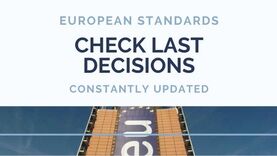Standards and other standardisation publications are voluntary guidelines providing technical specifications for products, services and processes - from industrial safety helmets or chargers for electronic devices, to service quality levels in public transport.
In some cases, standards are referenced in legislation as a preferred way or even as a mandatory requirement to comply with specific laws (i.e. safety legislation or interoperability requirements).
Standards are developed by private standardisation organisations usually on the initiative of stakeholders who see a need to apply a standard.
Although standards as such are voluntary, using them proves that your products and services reach a certain level of quality, safety and reliability.
In some cases, standards are referenced in legislation as a preferred way or even as a mandatory requirement to comply with specific laws (i.e. safety legislation or interoperability requirements).
Standards are developed by private standardisation organisations usually on the initiative of stakeholders who see a need to apply a standard.
Although standards as such are voluntary, using them proves that your products and services reach a certain level of quality, safety and reliability.
Using product standards
Standardised quality and safety of products helps your business to build consumer confidence. For example, tools and equipment designed and tested according to standards give better protection for professionals such as firefighters and hospital staff.
Services designed according to service standards, e.g. scuba diving courses, ensure a high level of quality and safety for the consumer.
Standards help to protect the environment and the consumers' health. For example, standards provide measurement methods to monitor and control air pollution. Food hygiene standards provide classification and test methods for materials in contact with food.
Better access to markets: standards can open up markets by making your products or services compatible and comparable.
Standards can help to improve interoperability between products or services. For example, standards advise on the size of the rail tracks to ensure the safety of trains.
European standards: ESO
European Standards are under the responsibility of the European Standardisation Organisations (CEN, CENELEC, ETSI) and can be used to support EU legislation and policies.
European standards are adopted by one of the 3 European standardisation organisations (ESOs):
National standards: NSO
At national level, standardisation is managed by national standardisation bodies (NSBs) who adopt and publish national standards. The NSBs also transpose all European standards as identical national standards and withdraw any conflicting national standards.
Choose a country to find the relevant national standardisation body: * Not notified
European standards are developed in close cooperation with industry and other relevant members or partners of the ESOs.
Small and medium enterprises are represented in the standard making process by the Small Business Standards association.
Harmonised standards
Harmonised standards are a specific category of European standards developed by an ESO following a request, known as a 'mandate', from the European Commission. About 20% of all European standards are developed following a standardisation request from the European Commission.
You can use harmonised standards to prove that your products or services comply with technical requirements of the relevant EU law.
Technical requirements given in EU legislation are mandatory, while the use of harmonised standards is usually voluntary.
Harmonised standards establish technical specifications which are considered suitable or sufficient in order to comply with the technical requirements given in EU legislation.
In most cases, using harmonised standards is voluntary. As a manufacturer or service provider you can choose another technical solution to fulfil the legal requirements.
How to find a standard
To search for a European standard you can use one of the search engines on the European standardisation organisations' portals:
- Cenelec for electrotechnical standards
- ETSI for telecommunication standards
- CEN for all other sector standards
Each of the national standardisation bodies (NSBs) has its own search engine. To find out more about the standards valid in each country, choose a country from the list above and follow the instructions.
Source: European Union, http://www.europa.eu/, 1998-2024
|
Brussels - Milano - Nice - Tokyo
|
eEuropa Belgium
Avenue Louise, 367 1050 Brussels BELGIUM Bld. Franck Pilatte, 19 bis
06300 Nice FRANCE YONO HOUSE 9-1 KAMIOCHIAI, SAITAMA-SHI, SAITAMA-KEN 〒 338-0001 JAPAN Via S. Veniero 6 20148 Milano ITALY |
All rights reserved - © Copyright eEuropa Belgium 2020-2024


